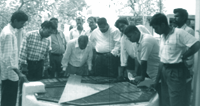| |
A NEW BEGINNING |
|
| By the people |
||
IN FOCUS |
||
| Open letter to the Prime Minister Atal Bihari Vajpayee Khandwa,Catching every droplet The lost pond |
||
CAMPAIGN |
||
| From the courtroom Face to face Destroy, then revive |
||
INITIATIVE |
||
| Woman power Paying up A tiny oasis in Uttar Pradesh Smile! CII’s water meet Rotary’s initiative Brick by brick Nurturing the future CSE’s pilgrims in Madhya Pradesh Taking initiative Experiments with water |
||
NEWS FROM GUJARAT |
||
| Pure
rain In a great hurry! |
||
JAL BIRADARI |
||
| As
priceless as amrit Reviving pynes |
||
JAL YODHA |
||
| D
V Subramanaian Ashutosh Agnihotri |
||
NEWS FROM CHENNAI |
||
| Rain centre inaugurated The Alacrity cycle Porous roads Plumbers’ meet Women’s meet |
||
CSE' LATEST DESIGNS |
||
| Making
a mark in Laburnam |
||
TECHNOLOGY |
||
| Pollutants
to bind roads Make your own rain gauge Smart farming tool Techno tit bits |
||
NEWS FROM ABROAD |
||

